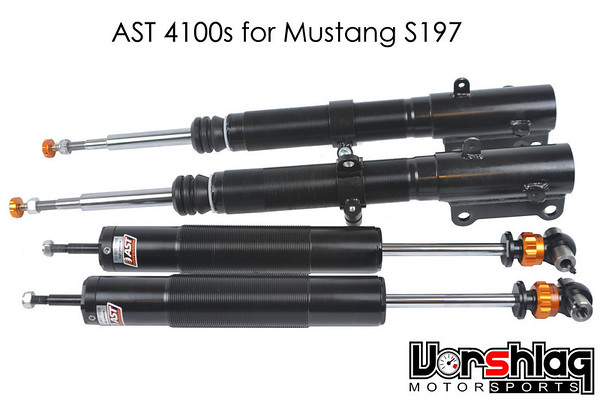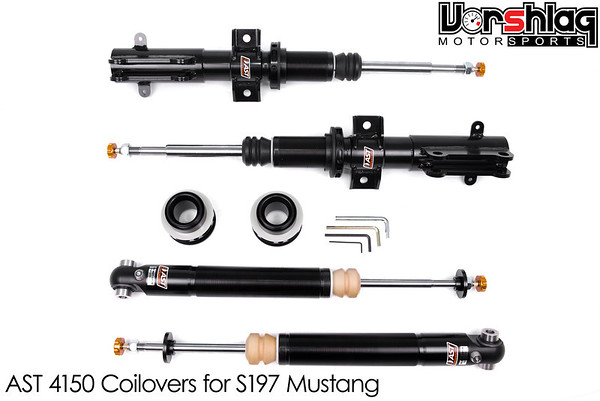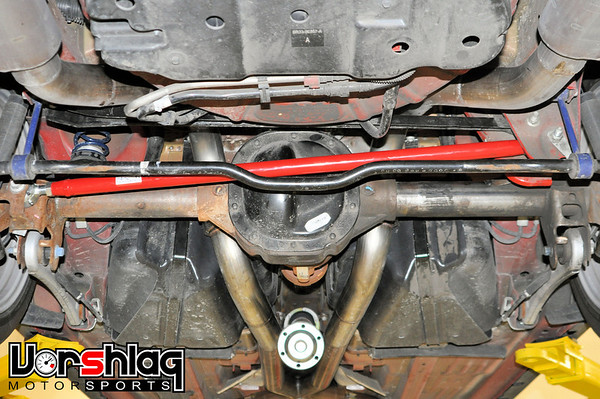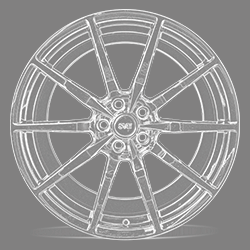sheizasosay
Alive
- Joined
- Jun 28, 2011
- Posts
- 1,024
- Reaction score
- 2
Spec Iron Coilovers
Ok, so after nobody had any info on these coilovers and only speculation in regards to the rears looking a lot like AST 4100's I talked via phone and email to Brian Hanchey of HVT. Actually I talked to a guy named John first who runs the Roehrig shock dyno and does rebuilds and custom valving jobs. I have never heard of Hanchey or HVT before Dontlifttoshift mentioned JRi's that he saw at SEMA. That's how I found the Iron Spec coilovers.
When I saw the front shaft I immediately thought "Bilstein Frankenstein", but in a different strut body. And as CSamsh pointed out, the rears looked suspiciously like the AST 4100's which apparently have had some serious issues. So, after having talked to Mr. Hanchey for a while, it turns out they have been supporting endurance races such as Grand Am Continental Tire Sports Car Series. I asked Brian a handful of questions and one of them was "why are those rears not AST 4100's". Brian's reply was: "They are not AST 4100s. Some parts are made to our spec by AST, but I don't really want to go down that road or discuss what is and is not made from them. Needless to say, I have personally lived through the disaster of AST 4100s (especially with Mustangs) and we have made something that works well and is made to last. Otherwise, we won't sell it. I'm done with untested products. The products we sell come directly out of our involvement with professional road racing. Three years of racing has shown us how to build this kit for the street and track. These are all proven parts from the street and track and should be considered better than 4150s."
The spring rate range the Spec Iron's were designed for are: fronts 350-600in/lb and rear 175-450in/lbs. They can do custom valving and I think he said about $75 a damper.
One of things he mentioned more than once was how little stiction these dampers have. He said the Spec Iron's, depending on the car, are within the 0-40lbs range. He listed competitors at about the 125lb range. I asked what G they tested it at and he replied 1.5G and thats as far as their equipment would allow. He mentioned top-tier dampers to include Moton when he was talking about stiction. Since the fronts on the Iron Specs looked like Bilstiens, I asked if they had tested the Bilsteins on their machine. He said he had not. I would be willing to bet it would be low on the Bilsteins, but that is still a guess. I know of one AIX champion that was running Bilsteins specifically because they were better with side loading. That's probably a discussion within itself in regards to side loading and stiction and what impact it can have.
I realize this isn't an all-inclusive info in regards to the Spec Iron coilovers. The obvious information is here: http://www.hancheyvehicletech.com/product/HVT-F1001-SI.html.
The other stuff on "specifically" what has been done to make these different you might be able to get if you called him. I don't know. For $2400 you get a full set of rebound adjustable, monotubes and they come with your choice of springs and have been engineered or spec'd out by a company supporting road racing for several years that can do rebuilds and shock dyno's and custom valving in-house has an appeal. There are other products they offer like the ability to adjust your damper settings in-car and with the push of a button select "oversteer" or "understeer" and lot of other features that while I think neat....WAY outside what I'm willing to pay. But I will give it the "neat" award.
Some interesting info: In 7-post rig testing, our new design created more grip than 22mm shaft race dampers. Recently, our new 6200r was the fastest Mustang in IMSA Daytona testing and beat all infield sector times for the pole position BMW during the test! Proving, our design handles better than some 4-Way designs from our competitors.
Furthermore, our HVT 6100 kit is used for NASA's Spec Iron race series that uses the Mustang S197 chassis. Spec Iron Mustangs are consistently running American Iron times, winning poles and even races in some regions. This is in full Spec Iron trim running against prepped American Iron cars! Our 6100 kit works well for dual-use vehicles that drive to the track and run track day weekends as well.
Ok, so after nobody had any info on these coilovers and only speculation in regards to the rears looking a lot like AST 4100's I talked via phone and email to Brian Hanchey of HVT. Actually I talked to a guy named John first who runs the Roehrig shock dyno and does rebuilds and custom valving jobs. I have never heard of Hanchey or HVT before Dontlifttoshift mentioned JRi's that he saw at SEMA. That's how I found the Iron Spec coilovers.
When I saw the front shaft I immediately thought "Bilstein Frankenstein", but in a different strut body. And as CSamsh pointed out, the rears looked suspiciously like the AST 4100's which apparently have had some serious issues. So, after having talked to Mr. Hanchey for a while, it turns out they have been supporting endurance races such as Grand Am Continental Tire Sports Car Series. I asked Brian a handful of questions and one of them was "why are those rears not AST 4100's". Brian's reply was: "They are not AST 4100s. Some parts are made to our spec by AST, but I don't really want to go down that road or discuss what is and is not made from them. Needless to say, I have personally lived through the disaster of AST 4100s (especially with Mustangs) and we have made something that works well and is made to last. Otherwise, we won't sell it. I'm done with untested products. The products we sell come directly out of our involvement with professional road racing. Three years of racing has shown us how to build this kit for the street and track. These are all proven parts from the street and track and should be considered better than 4150s."
The spring rate range the Spec Iron's were designed for are: fronts 350-600in/lb and rear 175-450in/lbs. They can do custom valving and I think he said about $75 a damper.
One of things he mentioned more than once was how little stiction these dampers have. He said the Spec Iron's, depending on the car, are within the 0-40lbs range. He listed competitors at about the 125lb range. I asked what G they tested it at and he replied 1.5G and thats as far as their equipment would allow. He mentioned top-tier dampers to include Moton when he was talking about stiction. Since the fronts on the Iron Specs looked like Bilstiens, I asked if they had tested the Bilsteins on their machine. He said he had not. I would be willing to bet it would be low on the Bilsteins, but that is still a guess. I know of one AIX champion that was running Bilsteins specifically because they were better with side loading. That's probably a discussion within itself in regards to side loading and stiction and what impact it can have.
I realize this isn't an all-inclusive info in regards to the Spec Iron coilovers. The obvious information is here: http://www.hancheyvehicletech.com/product/HVT-F1001-SI.html.
The other stuff on "specifically" what has been done to make these different you might be able to get if you called him. I don't know. For $2400 you get a full set of rebound adjustable, monotubes and they come with your choice of springs and have been engineered or spec'd out by a company supporting road racing for several years that can do rebuilds and shock dyno's and custom valving in-house has an appeal. There are other products they offer like the ability to adjust your damper settings in-car and with the push of a button select "oversteer" or "understeer" and lot of other features that while I think neat....WAY outside what I'm willing to pay. But I will give it the "neat" award.
Some interesting info: In 7-post rig testing, our new design created more grip than 22mm shaft race dampers. Recently, our new 6200r was the fastest Mustang in IMSA Daytona testing and beat all infield sector times for the pole position BMW during the test! Proving, our design handles better than some 4-Way designs from our competitors.
Furthermore, our HVT 6100 kit is used for NASA's Spec Iron race series that uses the Mustang S197 chassis. Spec Iron Mustangs are consistently running American Iron times, winning poles and even races in some regions. This is in full Spec Iron trim running against prepped American Iron cars! Our 6100 kit works well for dual-use vehicles that drive to the track and run track day weekends as well.
Last edited:









